Living Labs for Sustainable Protected Area Management in Greece: The Prespa Lakes Case
Abstract
1. Introduction
2. Materials and Methods
2.1. Study Area: The Prespa Lakes
2.2. Participatory Methodologies: SIA and LL
3. Results of Implementing Living Labs in the Prespa Area
3.1. Findings During the Workshops’ Preparation
3.2. National Workshop Implementation Results
3.2.1. First National Workshop
3.2.2. Second National Workshop
3.2.3. Third National Workshop
4. Discussion
5. Conclusions
Author Contributions
Funding
Institutional Review Board Statement
Informed Consent Statement
Data Availability Statement
Acknowledgments
Conflicts of Interest
Abbreviations
| Art. | Article. |
| CA | California. |
| EEC | European Economic Community. |
| EU | European Union. |
| H2020 | Horizon 2020. |
| LMC | Local Management Committee. |
| MEEN | Ministry of Environment and Energy. |
| NBS | Nature-Based Solutions. |
| NECCA | Natural Environment and Climate Change Agency. |
| NGOs | Nongovernmental Organizations. |
| p. | page. |
| PAMU | Protected Area Management Unit. |
| PAs | Protected Areas. |
| PESTLE | Political, Economic, Social, Technological, Legal, and Environmental. |
| POIs | Points of Interest. |
| SDGs | Sustainable Development Goals. |
| SIA | Systems Innovation Approach. |
| UN | United Nations. |
| USA | United States of America. |
Appendix A. Guiding Principles for the Future Vision
| SDG | Target | Guiding Principle |
|---|---|---|
| 6 | 6.3 By 2030, improve water quality by reducing pollution, eliminating dumping and minimizing release of hazardous chemicals and materials, halving the proportion of untreated wastewater and substantially increasing recycling and safe reuse globally |
|
| 6 | 6.4 By 2030, substantially increase water-use efficiency across all sectors and ensure sustainable withdrawals and supply of freshwater to address water scarcity and substantially reduce the number of people suffering from water scarcity |
|
| 6 | 6.5 By 2030, implement integrated water resources management at all levels, including through transboundary cooperation as appropriate |
|
| 8 | 8.9 By 2030, devise and implement policies to promote sustainable tourism that creates jobs and promotes local culture and products |
|
| 11 | 11.4 Strengthen efforts to protect and safeguard the world’s cultural and natural heritage |
|
| 13 | 13.1 Strengthen resilience and adaptive capacity to climate-related hazards and natural disasters in all countries |
|
| 12 | 12.1 Implement the 10-Year Framework of Programmes on Sustainable Consumption and Production Patterns, all countries taking action, with developed countries taking the lead, taking into account the development and capabilities of developing countries |
|
Appendix B. Future Vision “Prespa 2050”—Common Narrative
Appendix C. Backcasting Results
| Description | Timing | Theme(s)/Sector(s) |
|---|---|---|
| Plan educational system and producing educational material | 2025 | Education–Social Cohesion |
| Empower local society: local educational activities, including environmental education and traditional local practices, both for children and adults | 2030 | Education–Social Cohesion, Institutional–Legal Framework |
| Participatory governance | 2035 | Education–Social Cohesion, Institutional–Legal Framework |
| Collective work—Environment of collaboration | 2025–2030 | Education–Social Cohesion, Employment |
| Promote the touristic value of Prespa | 2025 | Tourism |
| Improve infrastructure (e.g., road network and pathways) to increase accessibility of Points of Interest (POIs) and support crisis management (e.g., wildfires) | 2025–2030 | Tourism, Forestry |
| Manage visitors, aiming to achieve equal distribution in space and time | 2030–2035 | Tourism |
| Research agriculture and water consumption | 2025–2030 | Agriculture |
| Increase effectivity in irrigation (reducing water losses) | 2030 | Agriculture |
| Promote grazing around the lakes | 2025–2030 | Livestock Farming, Fishery |
| Research invasive alien species, especially in lakes | 2025–2030 | Water–Environment–Biodiversity, Fishery |
| Increase quantity of fish to be caught | 2030–2035 | Fishery |
| Synergies among and between sectors (primary sector and tourism) | 2030 | Agriculture, Livestock Farming, Fishery, Tourism, Employment, Education-Social Cohesion |
| Transboundary crisis management (bird plagues, extreme weather events, and wildfires) | 2030 | Water–Environment–Biodiversity, Forestry |
| Modify institutional–legal framework for PAs | 2030 | Water–Environment–Biodiversity, Institutional–Legal Framework |
| Plan transboundary monitoring system; inventory of existing data | 2025 | Water–Environment–Biodiversity |
| Operate transboundary unified monitoring system/data harmonization | 2030 | Water–Environment–Biodiversity |
| Possible river diversion to Small Prespa | 2030–2035 | Water–Environment–Biodiversity |
| Limit lake vegetation/countering eutrophication | 2030–2035 | Fishery, Agriculture, Water–Environment–Biodiversity |
| Restore wet meadows | 2035 | Water–Environment–Biodiversity, Livestock Farming, Fishery |
| Economic incentives for activities in Natura 2000 PAs | 2030 | Water–Environment–Biodiversity, Employment |
| Study alien species in the lakes | 2025–2030 | Fishery, Water–Environment–Biodiversity |
| Manage invasive alien species in the lakes, substantially reducing their population | 2035 | Fishery, Water–Environment–Biodiversity |
| Administrative re-organization of mechanism | 2025–2030 | Institutional–Legal Framework |
| Immigration of population as part of decentralization | 2035-onwards | Employment |
| Innovation | Related Milestone(s) | Associated Actors |
|---|---|---|
| Drop Irrigation Smart Irrigation Systems Diversification of agriculture with less water-demanding crops | Increased effectiveness in irrigation (reducing water losses) | |
| Grazing Management Plan | Promote grazing around the lakes | Public authorities; private companies |
| Transboundary Crisis Management Plan | Crisis Management Plan (bird plagues, extreme weather events, and wildfires) | Ministry of Environment, NECCA |
| Transboundary updated Management Plan for PAs | Modification of institutional–legal framework for PAs | Transboundary Park Committee |
| Advanced grazing systems (NBS) | Promote grazing around the lakes; wet meadows restoration | |
| Innovative fishing methods and equipment | Management of invasive alien species in the lakes, substantially reducing their population | |
| Economic incentives for fishing invasive alien fish (e.g., cat food production from Lepomis gibbosus) | Management of invasive alien species in the lakes, substantially reducing their population | |
| Educational activities for environmental awareness targeted at professionals, seminars for children, and common educational activities | Empowering local society: local educational activities, including environmental education and traditional local practices, both for children and adults | |
| Programs of maintenance/creation of network of pathways for POIs | Improvement in infrastructure (e.g., road network and pathways) to increase accessibility of POIs and support crisis management (e.g., wildfires) | |
| Subsidy system for specific activities in Natura | Economic incentives for activities in Natura 2000 PAs | |
| Transboundary Visitor (Tourism) Management Plan | Management of visitors aiming to equal distribution in space and time |
References
- Manolache, S.; Nita, A.; Ciocanea, C.M.; Popescu, V.D.; Rozylowicz, L. Power, Influence and Structure in Natura 2000 Governance Networks. A Comparative Analysis of Two Protected Areas in Romania. J. Environ. Manage. 2018, 212, 54–64. [Google Scholar] [CrossRef] [PubMed]
- Council of European Communities. Council Directive 92/43/EEC of 21 May 1992 on the Conservation of Natural Habitats and of Wild Fauna and Flora. 1992. Available online: https://eur-lex.europa.eu/eli/dir/1992/43/oj/eng (accessed on 24 January 2025).
- Geitzenauer, M.; Hogl, K.; Weiss, G. The Implementation of Natura 2000 in Austria—A European Policy in a Federal System. Land Use Policy 2016, 52, 120–135. [Google Scholar] [CrossRef]
- Huber, J.M.; Newig, J.; Loos, J. Participation in Protected Area Governance: A Systematic Case Survey of the Evidence on Ecological and Social Outcomes. J. Environ. Manage. 2023, 336, 117593. [Google Scholar] [CrossRef]
- Chung, H.-S.E.; Jao, J.-C. Improving Marine Protected Area Governance: Concerns and Possible Solutions from Taiwan’s Practice. Mar. Policy 2022, 140, 105078. [Google Scholar] [CrossRef]
- Metcalfe, S. Impacts of Transboundary Protected Areas on Local Communities in Three Southern African Initiatives. 2003. Available online: https://www.tbpa.net/docs/WPCGovernance/SimonMetcalfe.pdf (accessed on 15 July 2025).
- EuroNatur Stiftung. Biodiversity—The Case of the Western Balkans. 2024. Available online: https://www.euronatur.org/fileadmin/docs/umweltpolitik/Biodiversitaet/EuroNatur_Biodiversity_Report_211124.pdf (accessed on 18 July 2025).
- Miller, D.C.; Nakamura, K.S. Protected Areas and the Sustainable Governance of Forest Resources. Curr. Opin. Environ. Sustain. 2018, 32, 96–103. [Google Scholar] [CrossRef]
- Oldekop, J.A.; Holmes, G.; Harris, W.E.; Evans, K.L. A global assessment of the social and conservation outcomes of protected areas. Conserv. Biol. 2016, 30, 133–141. [Google Scholar] [CrossRef]
- Hammond, A.; Jones, P.J. Protecting the ‘Blue Heart of the Planet’: Strengthening the Governance Framework for Marine Protected Areas beyond National Jurisdiction. Mar. Policy 2021, 127, 104260. [Google Scholar] [CrossRef]
- Laterra, P.; Weyland, F.; Auer, A.; Barral, P.; González, A.; Mastrángelo, M.; Rositano, F.; Sirimarco, X. MARCHI: A Serious Game for Participatory Governance of Ecosystem Services in Multiple-Use Protected Areas. Ecosyst. Serv. 2023, 63, 101549. [Google Scholar] [CrossRef]
- Global Water Partnership—Mediterranean (GWP-Med). Lake Ohrid Watershed Management Plan (LOWMP). 2020. Available online: https://www.gwp.org/globalassets/global/gwp-med-files/list-of-programmes/gef-drin-project/drin-docs/lake-ohrid-watershed-management-plan.pdf (accessed on 9 August 2025).
- Nikolaidis, N.; Troullaki, K.; Lilli, M.; Halasah, S.; Lehrer, D.; Rozakis, S.; Ajrami, A.; Al-Attili, S.; Zemah Shamir, S.; Jayyousi, A.; et al. An Integrated Participatory Framework for WEFE Nexus Strategic Planning: The Jordan Valley Case Study. J. Environ. Manage. 2025, 375, 124246. [Google Scholar] [CrossRef]
- Papazekou, M.; Tsavdaridou, A.I.; Almpanidou, V.; Mazaris, A.D. A River-Based Approach in Reconstructing Connectivity among Protected Areas: Insights and Challenges from the Balkan Region. J. Nat. Conserv. 2022, 67, 126182. [Google Scholar] [CrossRef]
- Vasilijević, M.; Zunckel, K.; McKinney, M.; Erg, B.; Schoon, M.; Rosen Michel, T. Transboundary Conservation: A Systematic and Integrated Approach; Groves, C., Phillips, A., Eds.; Best Practice Protected Area Guidelines Series No. 23; International Union for Conservation of Nature: Gland, Switzerland, 2015; ISBN 978-2-8317-1722-7. [Google Scholar]
- Guittard, A.; Akinsete, E.; Koundouri, P.; Tiller, R.; Viaene, P. A Systems Approach for the Sustainable Development of Coastal-Rural Regions. Department of International and European Economic Studies—Athens University of Economics and Business. Working Paper Series, 22-05. 2022. Available online: https://wpa.deos.aueb.gr/docs/COASTAL_SystemApproach_OceanCoastalmanagement_Final.pdf (accessed on 11 June 2024).
- Giordano, R.; Osann, A.; Henao, E.; López, M.L.; Piqueras, J.G.; Nikolaidis, N.P.; Lilli, M.; Coletta, V.R.; Pagano, A. Causal Loop Diagrams for Bridging the Gap between Water-Energy-Food-Ecosystem Nexus Thinking and Nexus Doing: Evidence from Two Case Studies. J. Hydrol. 2025, 650, 132571. [Google Scholar] [CrossRef]
- Tiwari, A.; Rodrigues, L.C.; Lucy, F.E.; Gharbia, S. Building Climate Resilience in Coastal City Living Labs Using Ecosystem-Based Adaptation: A Systematic Review. Sustainability 2022, 14, 10863. [Google Scholar] [CrossRef]
- Saguin, K.; Cashore, B. Two Logics of Participation in Policy Design. Policy Des. Pract. 2022, 5, 1–11. [Google Scholar] [CrossRef]
- Hatzilacou, D.; Kallis, G.; Mexa, A.; Coccosis, H.; Svoronou, E. Scenario Workshops: A Useful Method for Participatory Water Resources Planning? Water Resour. Res. 2007, 43, W06414. [Google Scholar] [CrossRef]
- White, D.D.; Jones, J.L.; Maciejewski, R.; Aggarwal, R.; Mascaro, G. Stakeholder Analysis for the Food-Energy-Water Nexus in Phoenix, Arizona: Implications for Nexus Governance. Sustainability 2017, 9, 2204. [Google Scholar] [CrossRef]
- Shahmohammadi, A.; Khoshbakht, K.; Veisi, H.; Nazari, M.R. Exploring Dynamics of Water, Energy, and Food Systems in Agricultural Landscapes Using Mental Modeling: A Case of Varamin Plain, Iran. Environ. Manage. 2023, 73, 34–50. [Google Scholar] [CrossRef]
- Ceseracciu, C.; Nguyen, T.P.L.; Deriu, R.; Branca, G.; Vozinaki, A.-E.K.; Karatzas, G.P.; Mellah, T.; Akrout, H.; Yıldırım, Ü.; Kurt, M.A.; et al. Innovative Governance for Sustainable Management of Mediterranean Coastal Aquifers: Evidence from Sustain-COAST Living Labs. Environ. Sci. Policy 2025, 167, 104038. [Google Scholar] [CrossRef]
- Syrou, D.; Botetzagias, I. Stakeholders’ Perceptions Concerning Greek Protected Areas Governance. Sustainability 2022, 14, 3389. [Google Scholar] [CrossRef]
- Vokou, D.; Dimitrakopoulos, P.G.; Jones, N.; Damialis, A.; Monokrousos, N.; Pantis, J.D.; Mazaris, A.D. The Natura-2000 Committee (2010–2013) members Ten Years of Co-Management in Greek Protected Areas: An Evaluation. Biodivers. Conserv. 2014, 23, 2833–2855. [Google Scholar] [CrossRef]
- Apostolopoulou, E.; Drakou, E.G.; Pediaditi, K. Participation in the Management of Greek Natura 2000 Sites: Evidence from a Cross-Level Analysis. J. Environ. Manage. 2012, 113, 308–318. [Google Scholar] [CrossRef]
- Hellenic Republic. Law 4685/2020—Government Gazette A/92/07.05.2020—Modernization of Environmental Legislation, Incorporation Into Greek Legislation of Directives 2018/844 and 2019/692 of the European Parliament and of the Council and Other Provisions. 2020. Available online: https://search.et.gr/el/fek/?fekId=604408 (accessed on 22 February 2025).
- Directorate of Natural Environment Management and Biodiversity—Department of Protected Areas, Ministry of Environment and Energy. Prioritised Action Framework (PAF) for Natura 2000 in Greece Pursuant to Article 8 of Council Directive 92/43/EEC on the Conservation of Natural Habitats and of Wild Flora and Fauna (the Habitats Directive) for the Multiannual Financing Period 2021–2027. 2024. Available online: https://ypen.gov.gr/wp-content/uploads/2024/03/Prioritised-Action-Framework-PAF-for-Natura-2000-for-the-Multiannual-Financing-Period-2021-2027.pdf (accessed on 13 March 2025).
- Hellenic Republic. Ministry of Environment and Energy (MEEN) Decision 21572/801—Government Gazette B/1273/18.03.2022—Definition of Responsibilities of the Local Management Committees, in Support of the Protected Area Management Units (P.A.M.U.) of the Natural Environment and Climate Change Agency (N.E.C.C.A.). 2022. Available online: https://search.et.gr/el/fek/?fekId=584886 (accessed on 24 January 2025).
- Catsadorakis, G.; Roumeliotou, V.; Koutseri, I.; Malakou, M. Multifaceted Local Action for the Conservation of the Transboundary Prespa Lakes Ramsar Sites in the Balkans. Mar. Freshw. Res. 2022, 73, 1174–1183. [Google Scholar] [CrossRef]
- Parisopoulos, G.; Sapountzakis, G.; Georgiou, P.; Giamouri, M.; Malakou, M. Development of Rule Curves for Sluice Gate Operation and Water Level Management in Lake Micro Prespa. In Proceedings of the 4th Conference on Water Observation and Information System for Decision Support (BALWOIS 2010), Ohrid, North Macedonia, 25–29 May 2010. [Google Scholar]
- van der Schriek, T.; Giannakopoulos, C. Determining the Causes for the Dramatic Recent Fall of Lake Prespa (Southwest Balkans). Hydrol. Sci. J. 2017, 62, 1131–1148. [Google Scholar] [CrossRef]
- Ministry of Environment and Energy, Special Secretariat for Water. 1st Update of the RBMP of the RBD of Western Macedonia (EL09). Government Gazette Approving the 1st Revision of RBMP: Β 4676/29.12.2017. 2017. Available online: https://search.et.gr/el/fek/?fekId=548744 (accessed on 24 January 2025).
- Matzinger, A.; Jordanoski, M.; Veljanoska-Sarafiloska, E.; Sturm, M.; Müller, B.; Wüest, A. Is Lake Prespa Jeopardizing the Ecosystem of Ancient Lake Ohrid? Hydrobiologia 2006, 553, 89–109. [Google Scholar] [CrossRef]
- van der Schriek, T.; Giannakopoulos, C.; Varotsos, K.V. The Impact of Future Climate Change on Bean Cultivation in the Prespa Lake Catchment, Northern Greece. Euro-Mediterr. J. Environ. Integr. 2020, 5, 14. [Google Scholar] [CrossRef]
- Catsadorakis, G.; Papadopoulou, E.; Petrakos, M.; Koutseri, I. Status of Fisheries at Megali Prespa Lake and Mikri Prespa Lake, Greece, Based on a Census of Fishermen’s Opinions. Environ. Ecol. Res. 2018, 6, 583–592. [Google Scholar] [CrossRef][Green Version]
- Malakou, M.; Alexandrou, O.; Catsadorakis, G.; Koutseri, I.; Nikolaou, C.; Nikolaou, L.; Papanousi, F.; Parisopoulos, G.; Sakellarakis, F.-N. Guideline Document on Wetland Vegetation Management in Lake Lesser Prespa (2022–2026). Report in the Framework of LIFE Prespa Waterbirds (LIFE15 NAT/GR/000 936); Society for the Protection of Prespa: Agios Germanos, Greece, 2021; p. 78. Available online: https://www.prespawaterbirds.gr/img/908062780a0ad4dd0b1f6a2699a68a7aGUIDELINE%20DOC%202022-2026%20pdf.pdf (accessed on 7 February 2025).[Green Version]
- van der Schriek, T.; Karali, A.; Varotsos, K.V.; Kitsara, G.; Giannakopoulos, C. Estimation of Future Drought and (Wetland) Fire Risk up to 2070 in Prespa; Report for the Project “Prespa’s Green and Blue LifeLines” Headed by the Society for the Protection of Prespa; Society for the Protection of Prespa: Agios Germanos, Greece, 2023; Available online: https://spp.gr/wp-content/uploads/2023/11/Estimation-of-future-drought-and-wetland-fire-risk-up-to-2070-in-Prespa.pdf (accessed on 22 May 2024).[Green Version]
- Council of the European Union. Council Decision of 23 May 2011 Concerning the Conclusion, on Behalf of the European Union, of the Agreement on the Protection and Sustainable Development of the Prespa Park Area. 2011; Volume 258. Available online: https://eur-lex.europa.eu/legal-content/EN/TXT/?uri=CELEX%3A32011D0646 (accessed on 13 December 2024).[Green Version]
- Hellenic Republic. Law 4453/2017—Government Gazette A/19/20.02.2017—Ratification of the Agreement between the Hellenic Republic, the Republic of Albania, the Former Yugoslav Republic of Macedonia and the European Commission for the Protection and Sustainable Development of the Prespa Park Area. 2017. Available online: https://search.et.gr/el/fek/?fekId=551626 (accessed on 28 April 2025).[Green Version]
- Kolaneci, M.; Krstic, S.; Tsiaoussi, V.; Parisopoulos, G. Expert Proposal for the Transboundary Water Monitoring System of the Prespa Park; Society for the Protection of Prespa: Agios Germanos, Greece, 2011; Available online: https://spp.gr/wp-content/uploads/2023/04/2011-Expert-proposal-for-the-transboundary-water-monitoring-system-of-the-Prespa-Park.pdf (accessed on 4 April 2024).[Green Version]
- PrespaNet NGO Network. A Plan for Transboundary Conservation in Prespa. 2021. Available online: https://ppnea.org/wp-content/uploads/2021/01/TSF-Laymans-1.pdf (accessed on 3 February 2024).[Green Version]
- La Jeunesse, I.; Moujan, C.; Akinsete, E.; Guittard, A.; Spiropoulou, A. Implementation of System Innovation Approach in All Case Studies. Intermediate Report. ARSINOE Deliverable 6.5, H2020 Grant No. 101037424. 2023. Available online: https://arsinoe-project.eu/securstorage/2024/03/ARSINOE_D6.5.pdf (accessed on 7 March 2025).[Green Version]
- Alamanos, A.; Koundouri, P.; Papadaki, L.; Pliakou, T.; Toli, E. Water for Tomorrow: A Living Lab on the Creation of the Science-Policy-Stakeholder Interface. Water 2022, 14, 2879. [Google Scholar] [CrossRef]
- Moujan, C.; La Jeunesse, I.; Akinsete, E.; Guittard, A. Description of Stakeholder Mapping for Case Studies. ARSINOE Deliverable 2.1, H2020 Grant No. 101037424. 2022. Available online: https://arsinoe-project.eu/securstorage/2024/03/ARSINOE_D2.1.pdf (accessed on 5 March 2025).
- Moujan, C.; La Jeunesse, I.; Akinsete, E.; Guittard, A. Reframing Transition Pathways and Values through System Innovation across 9 European Regions. In Proceedings of the OpenLivingLab Days Conference, Barcelona, Spain, 21–22 September 2023; European Network of Living Labs: Brussels, Belgium, 2023; pp. 12–19. [Google Scholar]
- Leminen, S.; Westerlund, M.; Nyström, A.-G. Living Labs as Open-Innovation Networks. Technol. Innov. Manag. Rev. 2012, 2, 6–11. [Google Scholar] [CrossRef][Green Version]
- European Commission, Directorate-General for the Information Society and Media. Living Labs for User-Driven Open Innovation: An Overview of the Living Labs Methodology, Activities and Achievements; European Communities: Luxembourg, 2008; ISBN 978-92-79-10358-2.[Green Version]
- Leal Filho, W.; Ozuyar, P.; Dinis, M.A.P.; Azul, A.M.; Garcia Alvarez, M.; da Silva Neiva, S.; Salvia, A.L.; Borsari, B.; Danila, A.; Vasconcelos, C.R. Living Labs in the Context of the UN Sustainable Development Goals: State of the Art. Sustain. Sci. 2023, 18, 1163–1179. [Google Scholar] [CrossRef]
- Scuderi, A.; Cascone, G.; Timpanaro, G.; Sturiale, L.; La Via, G.; Guarnaccia, P. Living Labs as a Method of Knowledge Value Transfer in a Natural Area. In Computational Science and Its Applications—ICCSA 2023 Workshops; Springer: Cham, Switzerland, 2023; pp. 537–550. ISBN 978-3-031-37110-3. [Google Scholar]
- Valkokari, K.; Hyytinen, K.; Leväsluoto, J. Living Labs as Enablers for Collaborative Innovation—Exploring Success Factors and Impacts. J. Innov. Manag. 2024, 12, 158–174. [Google Scholar] [CrossRef] [PubMed]
- Kasovska Georgieva, S.; Likar, D.; Trajkovska, S.; Roussos, O.; Grigoriadou, T.; Lalaj, N.; La Jeunesse, I. Enhancing Sustainability in Transboundary Regions: Stakeholder Engagement for Climate Resilience in Ohrid and Prespa Lakes under the H2020 ARSINOE Project. In Proceedings of the Twelfth International Conference on Environmental Management, Engineering, Planning & Economics, Mykonos Island, Greece, 25–29 May 2025; Grafima Publ.: Thessaloniki, Greece, 2025; pp. 272–280. [Google Scholar]
- Matti, C.; Martín Corvillo, J.M.; Vivas Lalinde, I.; Juan Agulló, B.; Stamate, E.; Avella, G.; Bauer, A. Challenge-Led System Mapping: A Knowledge Management Approach; Transitions Hub Series; EIT Climate-KIC: Brussels, Belgium, 2020; ISBN 978-2-9601874-3-4. [Google Scholar]
- de Vicente Lopez, J.; Matti, C. Visual Toolbox for System Innovation. A Resource Book for Practitioners to Map, Analyse and Facilitate Sustainability Transitions; Transitions Hub Series; Climate-KIC: Brussels, Belgium, 2016; ISBN 978-2-9601874-0-3. [Google Scholar]
- Guittard, A.; Akinsete, E.; Koundouri, P. Report on Pathways Identification in Case Studies, ARSINOE Deliverable 2.4, H2020 Grant No. 101037424. 2024; (Unpublished work).
- Hanninger, L.-M.; Laxa, J.; Ahrens, D. Rural Areas on Their Way to a Smart Village—Experiences from Living Labs in Bavaria. In Proceedings of the 33rd BLED eConference, online, 28–29 June 2020. [Google Scholar]
- Zavratnik, V.; Superina, A.; Stojmenova Duh, E. Living Labs for Rural Areas: Contextualization of Living Lab Frameworks, Concepts and Practices. Sustainability 2019, 11, 3797. [Google Scholar] [CrossRef]
- Eurostat. Rural Europe. Available online: https://ec.europa.eu/eurostat/statistics-explained/index.php?title=Rural_Europe (accessed on 3 November 2024).
- Society for the Protection of Prespa. Establishment and Operation of the Wetland Management Committee (WMC). Available online: https://spp.gr/project/wetland-management-committee/ (accessed on 14 November 2024).
- Soria, J.; Apostolova, N. Decrease in the Water Level of Lake Prespa (North Macedonia) Studied by Remote Sensing Methodology: Relation with Hydrology and Agriculture. Hydrology 2022, 9, 99. [Google Scholar] [CrossRef]
- Hellenic Statistical Authority. Population and Social Conditions—ELSTAT. Available online: https://www.statistics.gr/en/statistics/pop (accessed on 18 June 2024).
- Papadopoulos, A.G.; Baltas, P. Rural Depopulation in Greece: Trends, Processes, and Interpretations. Geographies 2024, 4, 1–20. [Google Scholar] [CrossRef]
- Papadopoulou, M.P.; Roussos, O.; Papadopoulou, L.; Hatzilacou, D. WEFE Nexus Governance Approach to Tackle Water Management Issues in a Transboundary Aquatic Ecosystem. In Proceedings of the EGU General Assembly 2023, Vienna, Austria, 24–28 April 2023; p. EGU23-1708. [Google Scholar]

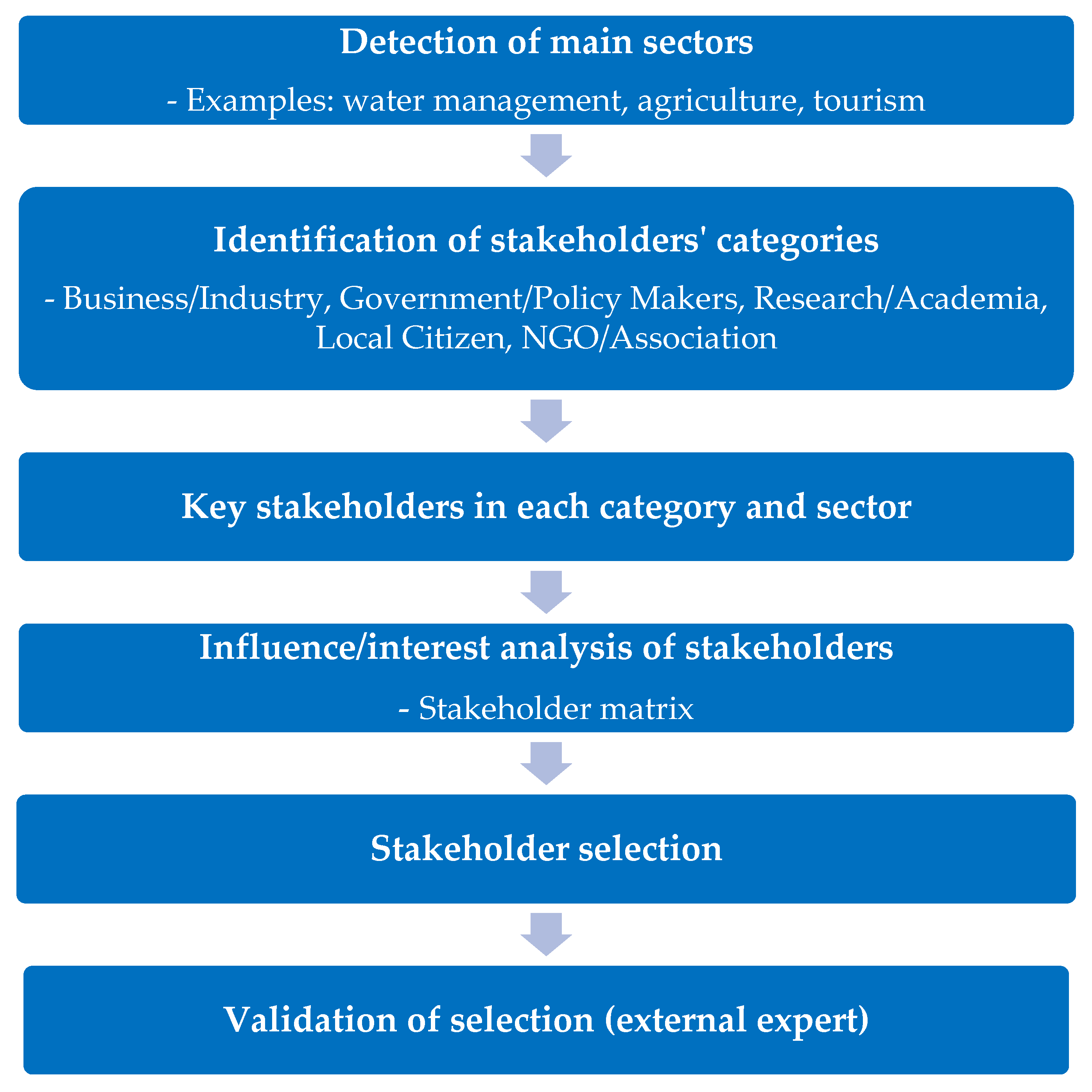
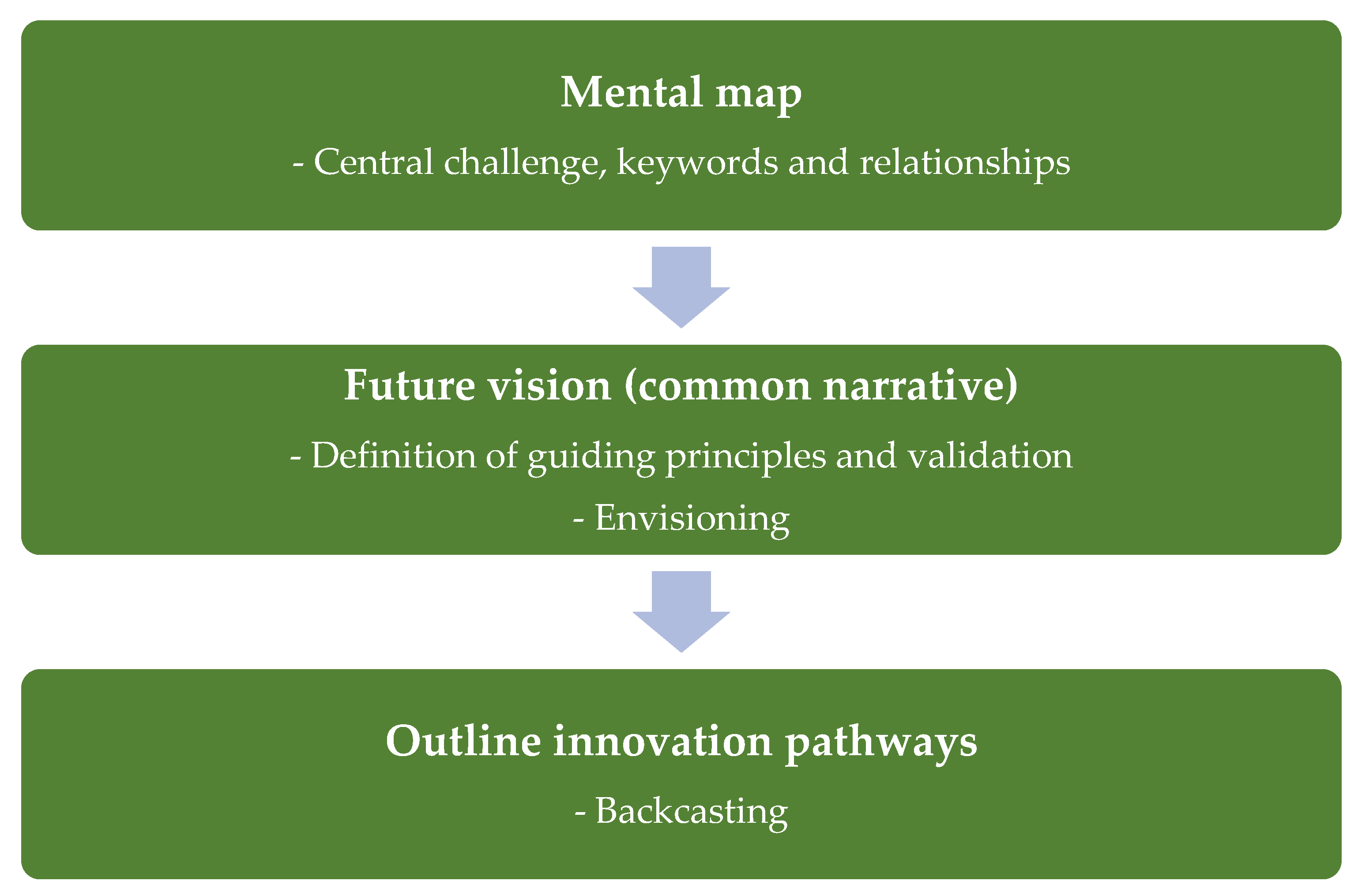

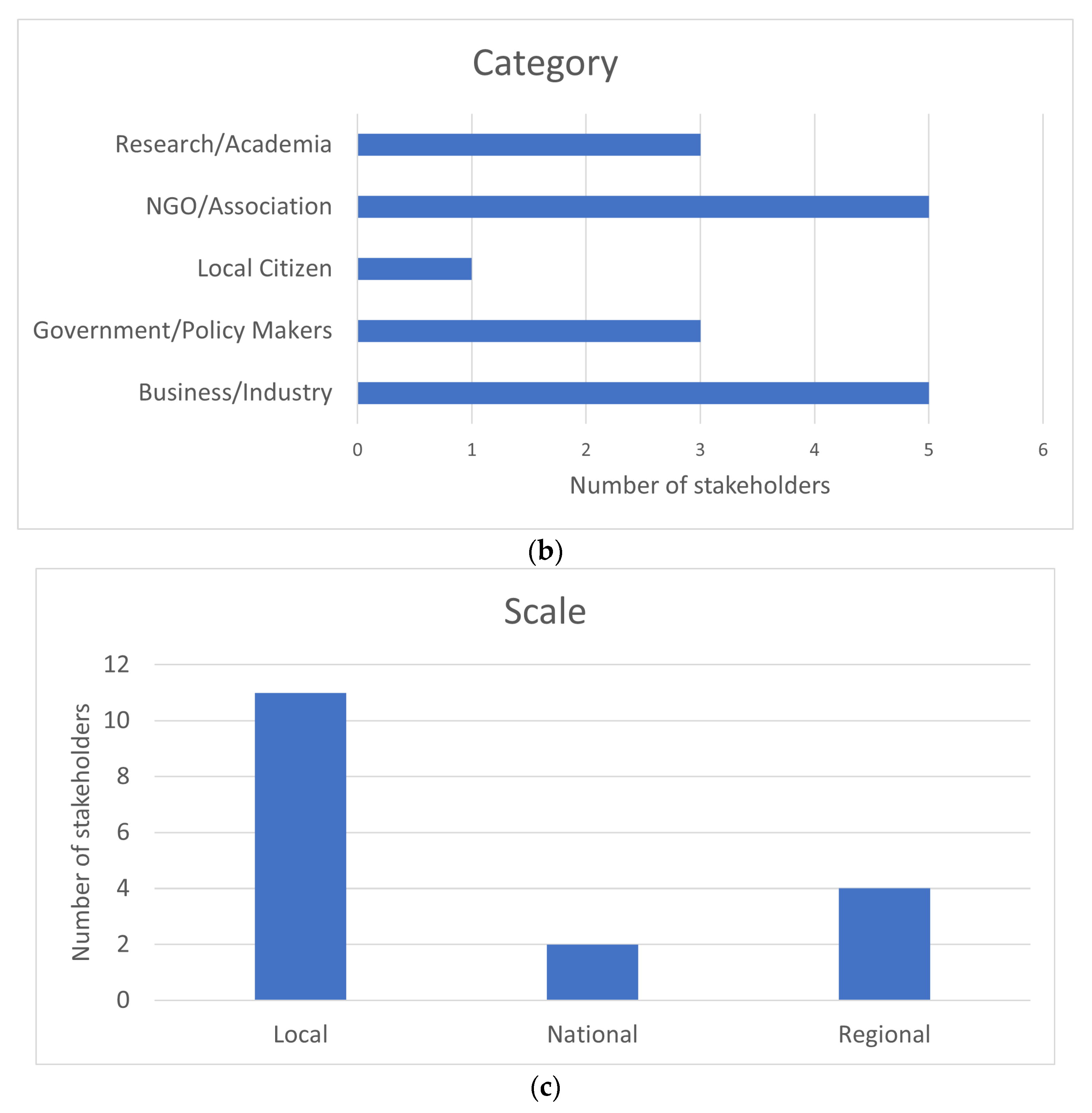
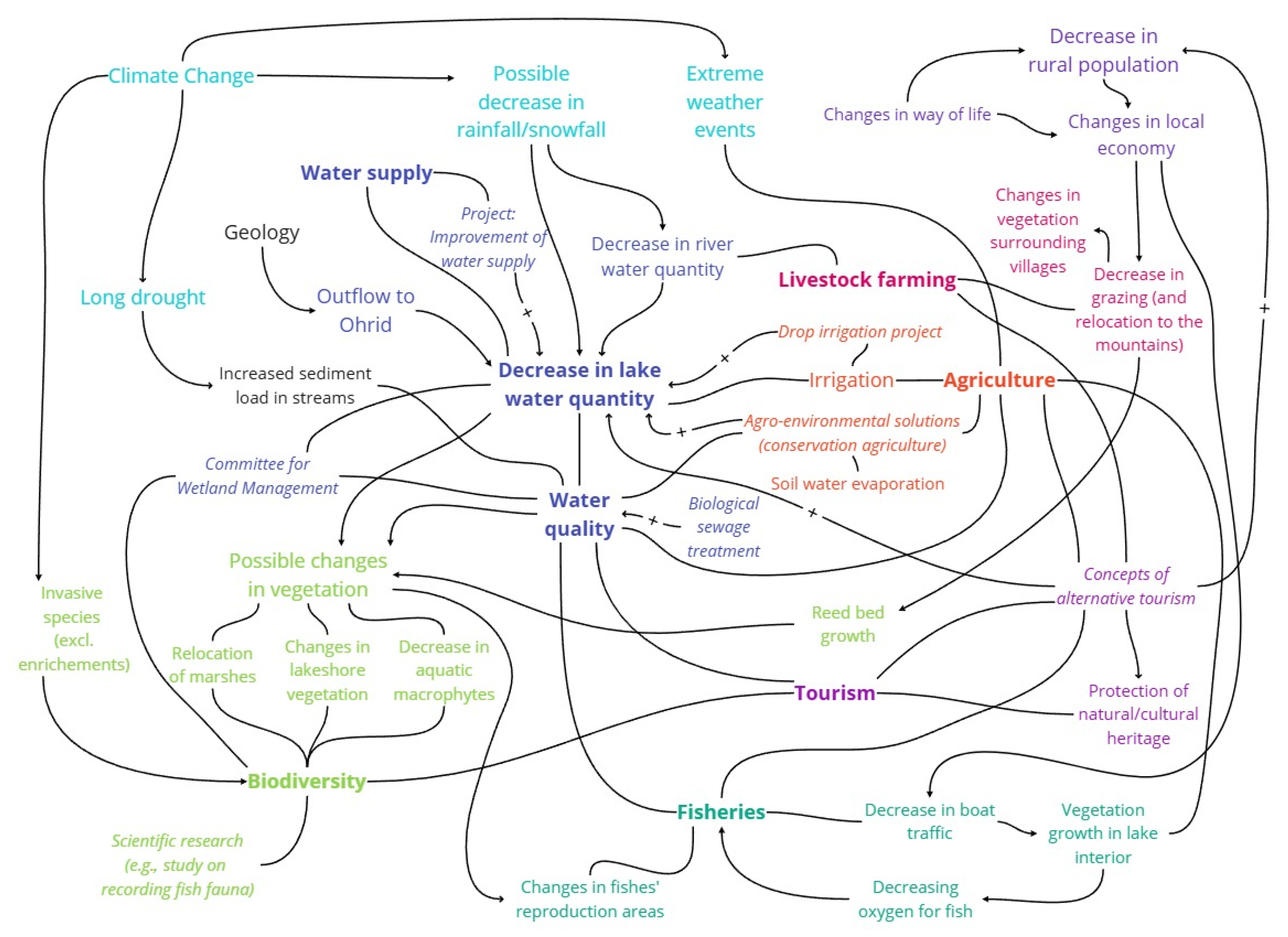
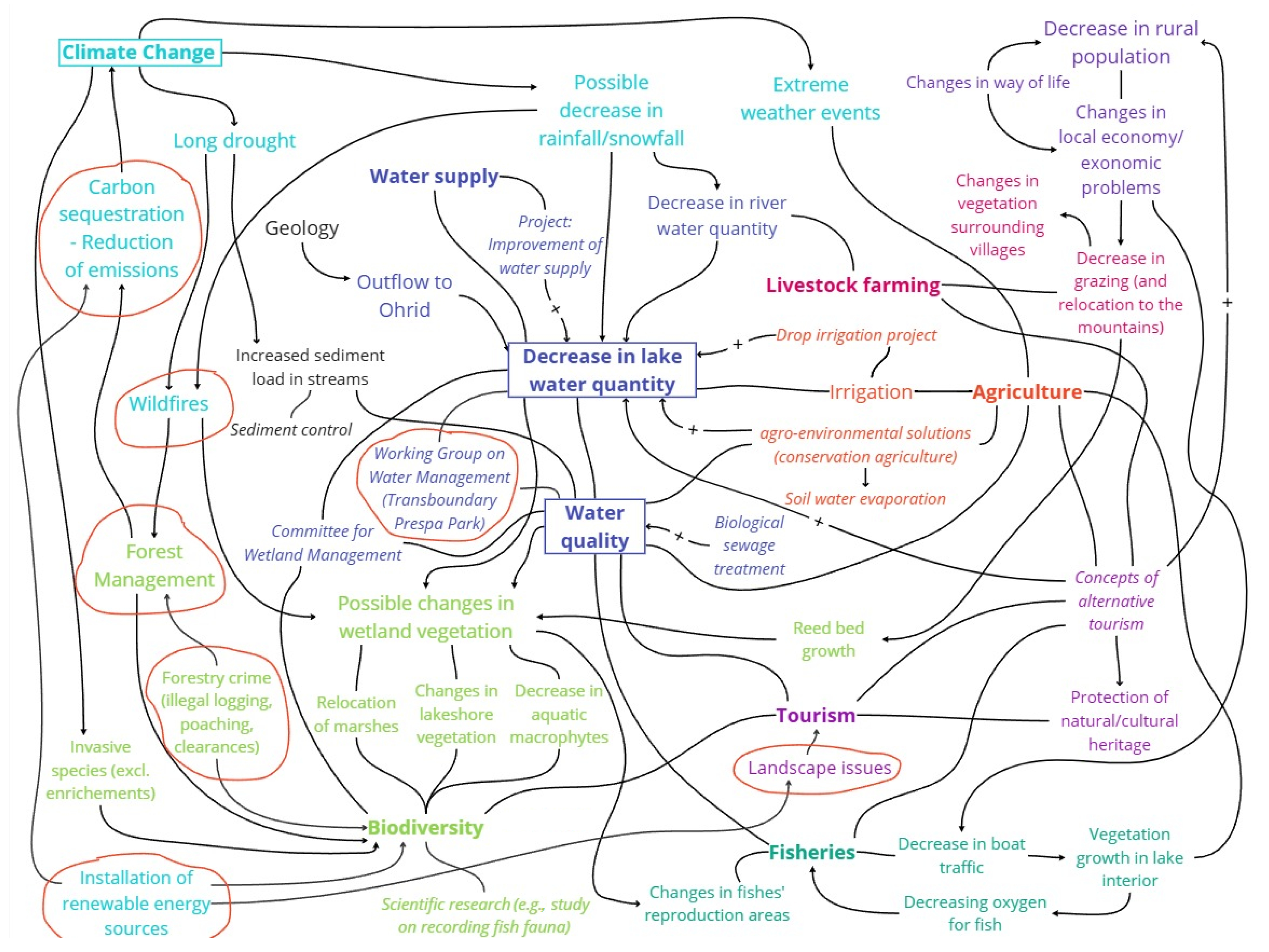

| Workshop | Scope | Methods | Outcomes |
|---|---|---|---|
| 1st |
| Mental mapping |
|
| 2nd |
| Envisioning |
|
| 3rd |
| Backcasting |
|
Disclaimer/Publisher’s Note: The statements, opinions and data contained in all publications are solely those of the individual author(s) and contributor(s) and not of MDPI and/or the editor(s). MDPI and/or the editor(s) disclaim responsibility for any injury to people or property resulting from any ideas, methods, instructions or products referred to in the content. |
© 2025 by the authors. Licensee MDPI, Basel, Switzerland. This article is an open access article distributed under the terms and conditions of the Creative Commons Attribution (CC BY) license (https://creativecommons.org/licenses/by/4.0/).
Share and Cite
Roussos, O.; Grigoriadou, E.T.; Voudouri, A.; Papadopoulou, L.; Gkogkou, T.; Basdeki, A.; Papadopoulou, M.P. Living Labs for Sustainable Protected Area Management in Greece: The Prespa Lakes Case. Sustainability 2025, 17, 8454. https://doi.org/10.3390/su17188454
Roussos O, Grigoriadou ET, Voudouri A, Papadopoulou L, Gkogkou T, Basdeki A, Papadopoulou MP. Living Labs for Sustainable Protected Area Management in Greece: The Prespa Lakes Case. Sustainability. 2025; 17(18):8454. https://doi.org/10.3390/su17188454
Chicago/Turabian StyleRoussos, Orfeas, Efthalia Thaleia Grigoriadou, Antigoni Voudouri, Lito Papadopoulou, Triantafyllia Gkogkou, Aikaterini Basdeki, and Maria P. Papadopoulou. 2025. "Living Labs for Sustainable Protected Area Management in Greece: The Prespa Lakes Case" Sustainability 17, no. 18: 8454. https://doi.org/10.3390/su17188454
APA StyleRoussos, O., Grigoriadou, E. T., Voudouri, A., Papadopoulou, L., Gkogkou, T., Basdeki, A., & Papadopoulou, M. P. (2025). Living Labs for Sustainable Protected Area Management in Greece: The Prespa Lakes Case. Sustainability, 17(18), 8454. https://doi.org/10.3390/su17188454






